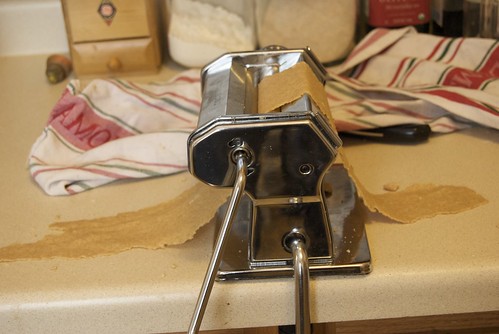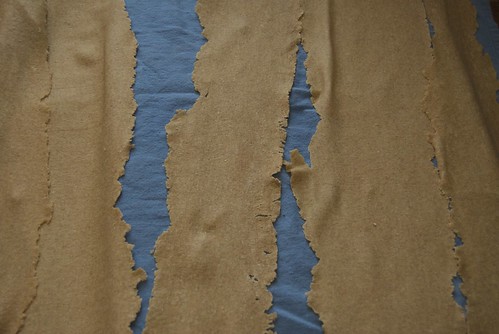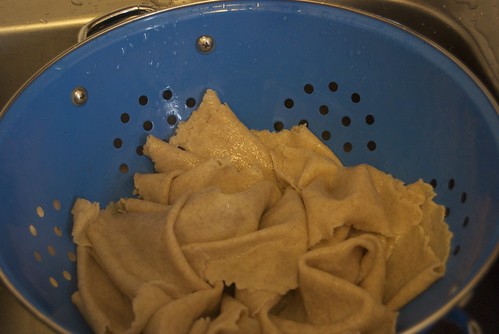
I know this is a busy time of year and maybe not the season to take on another project. But then again, it is a time for special meals and expanded tables full of loved ones. Often we think of rich or extravagant ingredients during this season of celebrating abundance but sometimes just taking the time to make something from scratch can be the touch that takes a meal from every day to special. Amidst all the hustling and bustling, it can be a blessing to slow down and make something by hand.

Homemade pasta is delightful in that it can be the focus of a weeknight meal or star in a more involved production such as ravioli or lasagna. I'm not sure why I highlight pasta for special occasions -- I am just remembering a snowy cold New Year's Eve two years ago when I organized a house full of guests in a grand ravioli production. Everyone had a lot of fun, ending in a delicious meal. The first Christmas Ray and I spent together was the occasion of my first lasagna from scratch and I've helped my mom put together many lasagnas for her annual Christmas parties.
I guess my association with homemade pasta tends toward the fancy and festive, but I am most happy to share this recipe because it makes for a hearty and wholesome meal anytime. It is certainly not as quick as throwing some dried pasta in boiling water, but the extra time is worth it for the flavor and texture of freshly made pasta. I like it tossed with pesto, covered in sauce, layered in lasagna, or stuffed for ravioli. I make my pasta with half whole wheat, half white flour. You can use all white flour, if you prefer, but I think the wheat adds greater flavor and texture.
I'll share my sauce recipe later in the week.

Fresh Pasta
2 cups flour (or one cup all purpose flour and one cup whole wheat flour)
2 large eggs
1 tablespoon olive oil or water (or more as needed to make a pliable dough)
1/4 teaspoon salt
Place the flour and salt in the bowl of a food processor or in a mixing bowl. Add the eggs one at a time and mix to combine. Gradually, add the olive oil. If you are mixing in a food processor, when the ingredients are fully incorporated gather them into a ball of dough and knead a couple of times. In the mixing bowl, knead the dough to incorporate as much of the flour as possible. In either case, if the dough is dry and not holding together well, add a tiny bit more water until you can form a smooth and slightly pliable ball of dough. Cover, and let rest for 15 minutes.
Divide the dough into five equal pieces. Use your hands to press the dough into a thin disk. If you are rolling by hand, roll it as thin as you can and then fold it over on top of itself. Continue to roll and fold until the dough is smooth. Then, roll the dough out as thin as you wish (the thickness of a penny or thinner is ideal). Once you have reached the desired thickness, you can cut the sheet of dough into smaller strips or squares for cooking. If you want to use it for lasagna, you can cut it into strips about 4 inches wide and as long as the pan you will be using. Repeat this with the rest of the dough.
If you are using a machine to roll out your dough, press it as thin as possible with your hands. Starting with the widest setting, roll the dough through. It may crumble at first, but keep rolling it through and putting it back together until the dough is smooth. Then move to the next smaller setting. Roll the dough through, fold it in half and roll it through again. Once it is totally smooth, you can decrease the settings and roll it only once. I usually go to setting 6 or 7 (the smallest setting on mine is 9). Repeat this with each piece of dough.
Before you cut your dough into the desired shapes and lengths, lay it carefully on a clean dishtowel or drape it over a dishtowel on the back of a chair. The pasta sheets can stick to each other if they are damp and overlapping. They can also easily dry out, so I separate them slightly and cover them with a damp dishcloth.
Cooking the Pasta:
Bring a large pot of water to a rolling boil. You will want a pot large enough so the pasta is not crowded and sticking to each other (for this recipe I used a seven quart pot which left plenty of room). Add a few teaspoons of salt to the water to flavor the pasta. Gently place the pasta in the boiling water and carefully stir it to keep the noodles from sticking to the pot or to each other. Fresh pasta cooks very quickly -- it is best to pull a piece out and taste it (run it under cold water so you don't burn your mouth) after a couple of minutes. When the pasta is done, you can drain it into a colander or scoop it out with a strainer or slotted pasta spoon. If you are not eating it right away (like noodles for lasagna) run cold water over the pasta in the colander to keep it from continuing to cook or sticking. If you are eating it right away, you can scoop it onto plates or add it directly to the sauce.
Yields enough pasta for a 9x13 inch pan of lasagna or 4 large servings of pasta.

I love making pasta. Thanks for your recipe. I usually make too much and it takes too long (4 eggs, 4 cups flour) and I didn't think to just cut that in half.
ReplyDeleteCasey, I'm glad this recipe might might your pasta making a bit easier. Once all the rolling is done, though, it's always worth it!
ReplyDelete